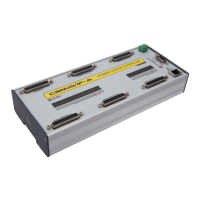• Time t=0s : output = 0
• Time t=1s : output = 10
• Time t=2s : output = 20
• …
• Time t=10s : output = 100
The example above shows that even a small error may cause large offset (correction) value if it lasts for
longer time. In practice we deal not with seconds but with fraction of seconds because the PID controllers
work from a few hundreds to several thousand times per second.
Matching the ’P’ and ‘I’ terms we get a controller which immediately reacts on large error values (P), and
some other deviations it corrects with small delay (I). So it all starts to work pretty well.
11.2.3 The Derivative term – D
After reading descriptions of ‘P’ and ‘I’ terms we can come to conclusion, that we do not need nothing
more. In many situations that is true and very often in practice the derivative gain ‘D’ is set to 0, what
cause it is skipped.
However sometimes there is necessity to add some stabilization element as "sharply" tuned ‘P’ and ‘I’ may
cause unwanted vibrations near the set point. Here the derivative term ‘D’ will be helpful which works as a
dumper - prevents sudden, rapid movements. The ‘D’ reacts the stronger the faster a position error chang-
es. If the error increases fast, the ‘D’ control will strongly react towards ‘-‘. If the error decreases fast then
the ‘D’ control will strongly react towards „+”.
11.2.4 The „sixth” sense – the mysterious K
VFF
parameter
Where this parameter comes from if we described all the terms of PID controller? Actually it is not another
PID controller term it is rather an element which makes PID controller work easier.
Looking carefully at all the three PID terms descriptions we can see that outputs of each term depend on a
position error. So the controller does not work if the position error is zero. The problem is that we want the
error to be as small as possible, the best if it would be zero because it means the best accuracy of work we
do.
Here we have the K
VFF
parameter which reacts in advance, before the error occurs. Of course working in
advance base on prediction and prediction is never 100% sure, so some error occur for sure and PID has
got then work to do but in practice well-matched K
VFF
gain is able to decrease temporary position errors
even up to ten times.
CS- Lab s.c. – CSMIO/IP- A - CNC controller
Page 79

